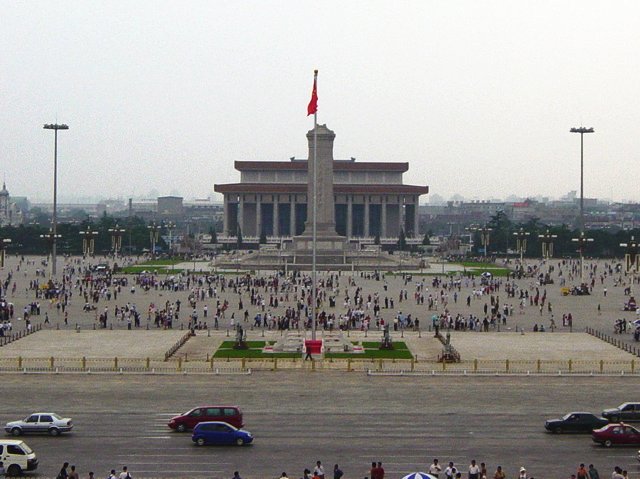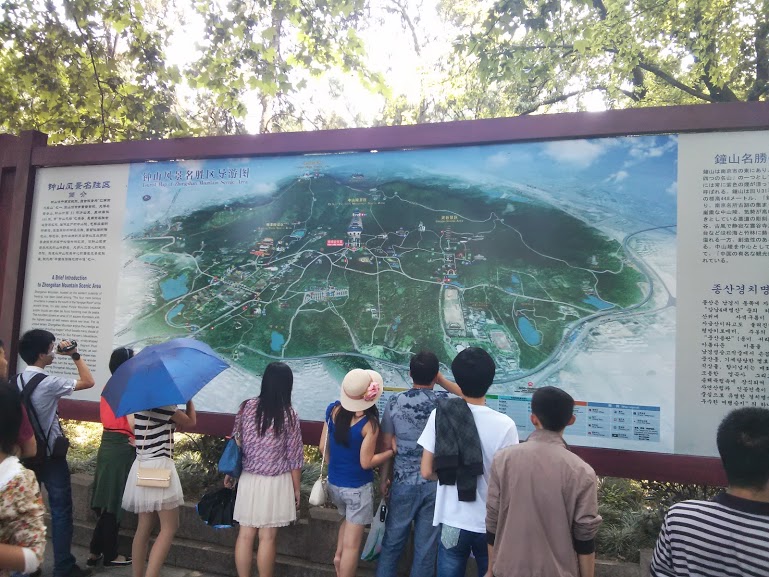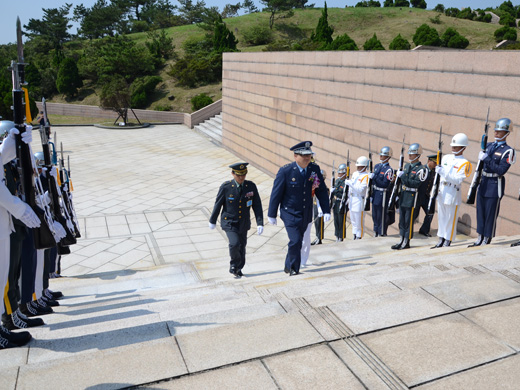|
Daxi Presidential Burial Place
Touliao Mausoleum or Daxi Mausoleum () is the resting place for Republic of China President Chiang Ching-Kuo located in Daxi District, Taoyuan City, Taiwan. History The Mausoleum building was originally known as the "Touliao guesthouse" and was constructed by RSEA Engineering and completed on July 17, 1966. The building's function was later changed to the presidential palace archives, and then to the Chiang family collection of information. When Chiang Ching-Kuo died on January 13, 1988 preparations were made to bring his body here for interment on January 30. The name of the building was subsequently renamed to Daxi Mausoleum. On January 13, 2001, the Taoyuan County Cultural Affairs Bureau announced the Mausoleum as a regional historic building. In 2006, the Taoyuan County government combined the Jiaobanshan villa, Cihu Presidential Burial Place, and Touliao Mausoleum into the "Chiang's Cultural Park". The Touliao Mausoleum building is about one kilometer from the Cihu P ... [...More Info...] [...Related Items...] OR: [Wikipedia] [Google] [Baidu] |
Daxi District
Daxi District (), formerly known as Daxi Township (), is a district in eastern Taoyuan City, Taiwan. In March 2012, it was named one of the ''Top 10 Small Tourist Towns'' by the Tourism Bureau of Taiwan. History The Daxi area was occupied for several thousand years by the Atayal people. The Atayal called the local river (modern-day Dahan Creek) ''Takoham'' in their native Austronesian language. This gave rise to similar names such as ''Toa-kho-ham'' (; also ) in Hokkien and ''Taikokan'' in Japanese via transliteration. Eighteenth-century Han settlement in the Taipei Basin led many Atayal families to relocate upriver, though some Atayal stayed and mingled with the newcomers. The settlement later became an important trading post in the 19th century. In 1803, open fighting broke out between two rival factions of Han settlers in Taipei, and many refugees fled south for safety. Among the refugees was the Lin Ben Yuan Family, one of the wealthiest clans in Taiwan at the time. ... [...More Info...] [...Related Items...] OR: [Wikipedia] [Google] [Baidu] |
Ching-kuo Memorial Hall
The Ching-kuo Memorial Hall () is a memorial hall dedicated to former President of the Republic of China Chiang Ching-kuo located in Nangan Township, Lienchiang County, Taiwan. History After President Chiang Ching-kuo passed away on 13 January 1988, political and military chiefs in Lienchiang discussed the construction of memorial to commemorate the President. The construction of the memorial hall was completed in June 1994. Architecture The memorial hall is located in a 2-story building on a hill. It has a total area of around 100 hectares. It was constructed with blue tile and white wall style, taking reference from the Sun Yat-sen Mausoleum in Nanjing and Chiang Kai-shek Memorial Hall in Taipei. The front wall is decorated with a sculpture of President Chiang. Exhibitions The ground floor displays a bronze seated statue of Chiang Ching-kuo with his last testament, including mails. The upper floor displays photos during his visits to Lienchiang and his hand-written document ... [...More Info...] [...Related Items...] OR: [Wikipedia] [Google] [Baidu] |
Buildings And Structures In Taoyuan City
A building, or edifice, is an enclosed structure with a roof and walls standing more or less permanently in one place, such as a house or factory (although there's also portable buildings). Buildings come in a variety of sizes, shapes, and functions, and have been adapted throughout history for a wide number of factors, from building materials available, to weather conditions, land prices, ground conditions, specific uses, prestige, and aesthetic reasons. To better understand the term ''building'' compare the list of nonbuilding structures. Buildings serve several societal needs – primarily as shelter from weather, security, living space, privacy, to store belongings, and to comfortably live and work. A building as a shelter represents a physical division of the human habitat (a place of comfort and safety) and the ''outside'' (a place that at times may be harsh and harmful). Ever since the first cave paintings, buildings have also become objects or canvasses of much artistic ... [...More Info...] [...Related Items...] OR: [Wikipedia] [Google] [Baidu] |
Buildings And Structures Completed In 1966
A building, or edifice, is an enclosed structure with a roof and walls standing more or less permanently in one place, such as a house or factory (although there's also portable buildings). Buildings come in a variety of sizes, shapes, and functions, and have been adapted throughout history for a wide number of factors, from building materials available, to weather conditions, land prices, ground conditions, specific uses, prestige, and aesthetic reasons. To better understand the term ''building'' compare the list of nonbuilding structures. Buildings serve several societal needs – primarily as shelter from weather, security, living space, privacy, to store belongings, and to comfortably live and work. A building as a shelter represents a physical division of the human habitat (a place of comfort and safety) and the ''outside'' (a place that at times may be harsh and harmful). Ever since the first cave paintings, buildings have also become objects or canvasses of much artistic ... [...More Info...] [...Related Items...] OR: [Wikipedia] [Google] [Baidu] |
1966 Establishments In Taiwan
Events January * January 1 – In a coup, Colonel Jean-Bédel Bokassa takes over as military ruler of the Central African Republic, ousting President David Dacko. * January 3 – 1966 Upper Voltan coup d'état: President Maurice Yaméogo is deposed by a military coup in the Republic of Upper Volta (modern-day Burkina Faso). * January 10 ** Pakistani–Indian peace negotiations end successfully with the signing of the Tashkent Declaration, a day before the sudden death of Indian prime minister Lal Bahadur Shastri. ** The House of Representatives of the US state of Georgia refuses to allow African-American representative Julian Bond to take his seat, because of his anti-war stance. ** A Commonwealth Prime Ministers' Conference convenes in Lagos, Nigeria, primarily to discuss Rhodesia. * January 12 – United States President Lyndon Johnson states that the United States should stay in South Vietnam until Communist aggression there is ended. * January 15 – 1966 Nigerian coup ... [...More Info...] [...Related Items...] OR: [Wikipedia] [Google] [Baidu] |
Mausoleum Of Mao Zedong
The Chairman Mao Memorial Hall (), also known as the Mausoleum of Mao Zedong, is the final resting place of Mao Zedong, Chairman of the Politburo of the Chinese Communist Party from 1943 and the Chairman of the Chinese Communist Party from 1945 until his death in 1976. Although Mao had wished to be cremated, his wishes were ignored and his body was embalmed. The construction of a memorial hall as his final resting place began shortly after his death. This highly popular attraction is located in the middle of Tiananmen Square in Beijing. It stands on the previous site of the Gate of China, the southern (main) gate of the Imperial City during the Ming and Qing dynasties. The embalmed body of Chairman Mao is preserved in the cooler, central hall of the memorial hall in a glass case with dim lighting; it is guarded by a military honor guard. The memorial hall is open to the public every day except Mondays. History The memorial hall was built soon after Mao's death on Septembe ... [...More Info...] [...Related Items...] OR: [Wikipedia] [Google] [Baidu] |
Chen Cheng
Chen Cheng (; ; January 4, 1898 – March 5, 1965) was a Chinese political and military leader, and one of the main commanders of the National Revolutionary Army during the Second Sino-Japanese War and the Chinese Civil War. After moving to Taiwan at the end of the civil war, he served as the Governor of Taiwan Province, Vice President, and Premier of the Republic of China (ROC). He represented the ROC in visits to the United States and helped to initiate land reforms and tax reduction programs that caused communism to become unattractive in Taiwan since peasants were able to own land. His courtesy name was Chen Tsyr-shiou (). Early life Chen Cheng was born in Qingtian County, Zhejiang, graduated from Baoding Military Academy in 1922, and entered Whampoa Military Academy two years later. It was there that he first met Chiang Kai-shek, Commandant of the Academy. Later, Chen joined National Revolutionary Army to participate in the Northern Expedition. Rise in military Duri ... [...More Info...] [...Related Items...] OR: [Wikipedia] [Google] [Baidu] |
Cihu Mausoleum
Cihu Mausoleum (), officially known as the Mausoleum of Late President Chiang () or President Chiang Kai-shek Mausoleum, is the final resting place of President Chiang Kai-shek. It is located in Daxi District, Taoyuan City, Taiwan. When Chiang Kai-shek died in 1975, he was not buried in the traditional Chinese fashion but entombed in a black marble sarcophagus that can be seen today at the mausoleum. Lake and residence Cihu (慈湖) literally means "benevolence lake", and it refers to the eight acre (32,000 m²) lake located near the tomb-site. The lake is divided into two smaller lakes, 5 acres (20,000 m²) and 3 acres (12,000 m²) each with a canal connecting them together. It was formerly called "Green Water Lake" () until Chiang Kai-shek renamed it as "Cihu" in 1962 because the scenery reminded him of his benevolent mother and his home town, Fenghua. Chiang loved the lake so much that he had an official residence built nearby to architecturally resemble the hous ... [...More Info...] [...Related Items...] OR: [Wikipedia] [Google] [Baidu] |
Sun Yat-sen Mausoleum
Dr. Sun Yat-sen's Mausoleum () is situated at the foot of the second peak of Purple Mountain in Nanjing, China. Construction of the tomb started in January 1926, and was finished in spring of 1929. The architect was Lü Yanzhi, who died shortly after it was finished. His representative and project partner was his close friend Huang Tanpu. History Dr. Sun was born in Guangdong province of China on 12 November 1866, and died in 1925 in Beijing, China. On 23 April 1929, the Chinese government appointed He Yingqin to be in charge of laying Dr. Sun to rest. On 26 May, the coffin departed from Beijing, and on 28 May, it arrived in Nanjing. On 1 June 1929, Dr. Sun was buried there. Sun, considered to be the "Father of Modern China" both in mainland China and in Taiwan, fought against the imperial Qing government and after the 1911 revolution ended the monarchy, and founded the Republic of China. Selection of the design A committee decided to host a design competition in order t ... [...More Info...] [...Related Items...] OR: [Wikipedia] [Google] [Baidu] |
Chiang Ching-kuo Memorial Hall
The Chiang Ching-kuo Memorial Hall () is a memorial hall dedicated to former President of the Republic of China Chiang Ching-kuo located in Jinning Township, Kinmen County, Taiwan. History The memorial hall was built in 1989. On 6 July 2008, the memorial hall was reopened in a ceremony attended by legislator Chen Fu-hai, Fujian Province Governor Hsueh Hsiang-chuan, Magistrate Lee Chu-feng, local officials, elected representatives and Chiang Ching-kuo's friends. The memorial hall was closed for renovation from 20 June until 30 November 2019 and was reopened at the end of 2019. Exhibitions The exhibition area of the memorial hall is divided into two part, which are the life of Chiang Ching-kuo and Chiang Ching-kuo's time in Kinmen. See also * List of tourist attractions in Taiwan * Touliao Mausoleum Touliao Mausoleum or Daxi Mausoleum () is the resting place for Republic of China President Chiang Ching-Kuo located in Daxi District, Taoyuan City, Taiwan. History The Mausol ... [...More Info...] [...Related Items...] OR: [Wikipedia] [Google] [Baidu] |
Wuzhi Mountain Military Cemetery
The Wuzhi Mountain Military Cemetery (, sometimes romanized as ''Wuchih'') is Taiwan's most prominent military cemetery. The cemetery is located on Wuzhi Mountain () at an elevation of in Xizhi, New Taipei City and borders Taipei City's Neihu District and Yangmingshan National Park. The cemetery has a wide open view ranging from the Taipei 101 over at Taipei's Xinyi District to the Keelung Harbor. History General Chiang Wei-kuo, the adopted son of Chiang Kai-shek, conceived and designed the cemetery. Prior to the construction of the cemetery, the land was used as a golf course. Planning for the cemetery started in April 1980, with construction starting on March 20, 1981; the cemetery opened on March 29, 1982. A four-story columbarium named the Memorial Palace () was opened on January 20, 2002 after two years of construction. It has a total capacity of 19,537 niches on the four named floors: # # # # Issues Capacity Although the cemetery has nearly 226 hectares total ... [...More Info...] [...Related Items...] OR: [Wikipedia] [Google] [Baidu] |





